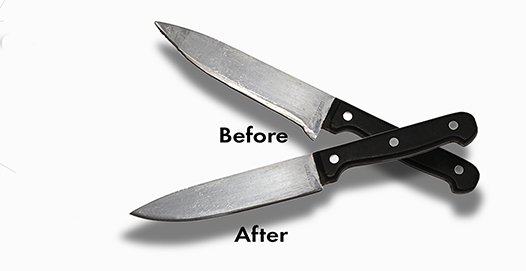Heels can cause a tricky situation for professional grinderies that not only caters to pros like chefs, butchers, and restaurants, but also to the general public. This is because the pros require that the heels get sharpened down to the same level as the rest of the edge – they are aware that the entire cutting edge, all the way back to the heel, needs to access the cutting surface with ease. This is only possible if the thick part of the heel gets properly aligned with the rest of the cutting edge. Understandably, having your heel sharpened down can cause confusion if you are not familiar with sharpening in these circumstances. Worry not, however! If your knife leaves no considerable space between its edge and your cutting board then your sharpener has done a good job.
Not all heels are equal
Some knives’ heels are left alone when the cutting edge gets sharpened. These knives are of a smaller size, e.g. paring knives. The reason these heels aren’t sharpened down is because the index finger of whoever is operating them more than likely touches the cutting board before its heel does. Because of this, we at Sharpenters don’t sharpen down these types of heels and rather prioritize keeping the knife’s balance intact. If you are adamant on having the heel of a smaller knife sharpened down we will of course assist with this (feel free to reach out at hello@sharpenters.com), but otherwise our standard services offer a perfectly aligned and sharpened heel for larger knives, and a largely untouched heel on smaller knives.

All of the cutting edge should reach the cutting board with ease
The reason why sharpening down an asymmetric heel is highly recommended is because the entire length of the cutting edge needs to easily reach the cutting board. When only the edge of a kitchen knife is sharpened and the heel is left untreated, the entire function of the knife has been changed. In a situation like this the usage will be limited, and regular activities like chopping chives or other produce where the entire cutting edge needs to interact with the cutting board will become a challenge.

The guard gets brought up a notch
When working with heels that require treatment, we aim to "round up" the heel toward the handle slightly, rather than grinding it in a right angle. In our vast experience, this has been the most appreciated approach as knife users can maintain their tools with greater ease this way. If the owner of the knife wishes to sharpen it between professional treatments, this approach will allow for significantly more freedom. If the heel is left at a right angle (which may be aesthetically more pleasing, on the other hand) only a few sharpenings later the same initial challenge will arise; the cutting edge will no longer be aligned with the heel, which now becomes an obstacle and not a natural part of the tool.

Hollow heels
Low-budget knives with a heel are often hollow in that part of the knife (this saves the manufacturer a bit of material costs). When we receive these types of knives, we attempt to avoid sharpening the heel, despite generally being considered best practice as explained above. This is because an exposed, hollow heel becomes a perfect hideout for dirt, dust, and bacteria, neither of which should have no place near your food nor kitchen tools.
